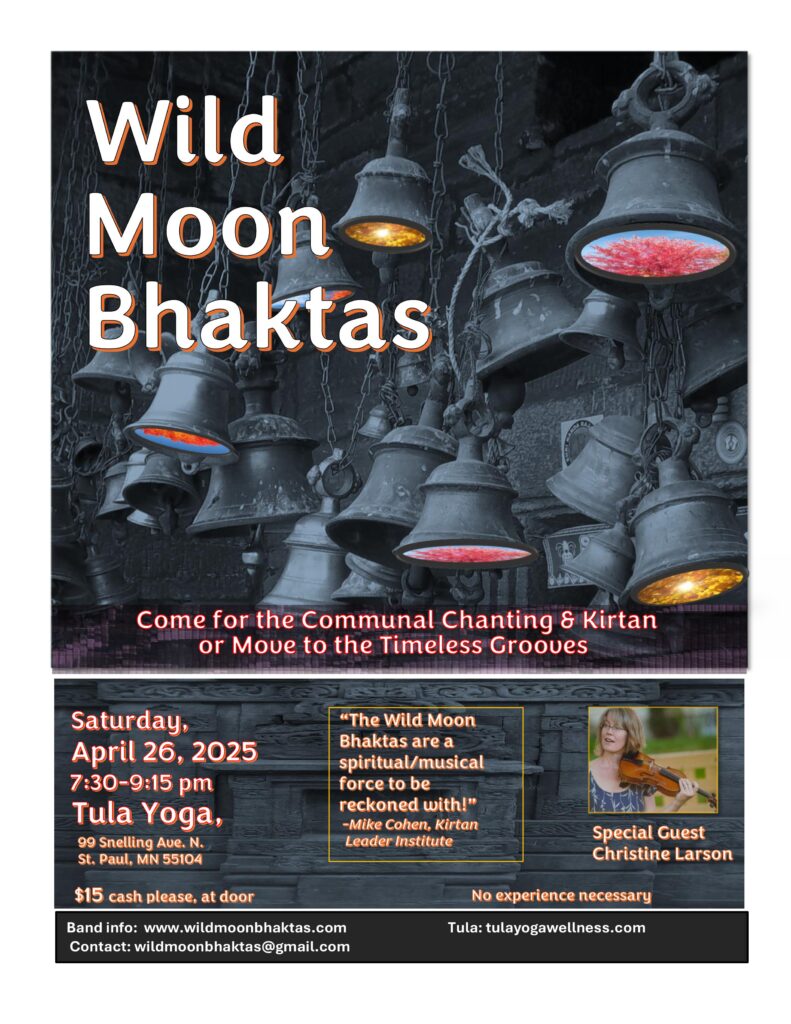-
Communal Chanting, Kirtan, Spiritual Music
-
-
-
Upcoming Appearances
-
- Saturday, April 26, 2025
Wild Moon Bhaktas - an evening of chanting, kirtan & spiritual music
with special guest, Christine Larson
7:30-9:15 pm
Tula Yoga, 99 Snelling Ave. North
St. Paul, MN 55104
$15 cash please, at door
- Saturday, May 10, 2025
Great Mother Chant - an evening of world chants & songs to the Divine Feminine
with the Wild Moon Bhaktas
Special guest: Barbara Meyer, Minnesota songstress
7:30 - 9:15 pm
Tula Yoga, 99 Snelling Ave. North
St. Paul, MN 55104
$15 cash please, at door

What is Kirtan?
For ages, illumined souls have used the repetition of sacred phrases as a means to connect with Spirit. Beginning in the 7th and 8th centuries in India, and then flowering in the 15th century, a powerful form of communal devotional chanting developed, some of it lively, energetic, and musical, called kirtan. Kirtan became synonymous with Bhakti yoga, the path of liberation of the soul through love for the Divine. It is a based on a simple premise: heartfelt singing to the Great Mystery deepens the soul. Something very similar to Bhakti appears in other world sacred traditions. But it is with India’s Bhakti yoga movement that this sacred musical chanting form has spread its wings and traveled internationally. Bhakti yoga-based kirtan groups now perform on five continents.
The founders of India’s Bhakti movement were spiritual rebels who eschewed religious formalities and rejected separations between people due to sect, race, class, creed, or gender. They urged direct communion with the Divine for all. A generous spirit of equality and freedom of mind has been retained in this movement to this day. It is “multi-non denominational.” Since kirtan is built upon music and music is a universal language, people of many backgrounds can appreciate it as a form of art. This openness means that people come to it by way of their own personal journeys and engage it in their own way. At the same time, the highest spiritual music must speak to the universal family of humankind and bring goodness to the ones who sing it. Kirtan aspires towards this ideal. India’s ancient sacred texts, the Vedas, recognize this many sidedness. The truth, so claims the Vedas, “has many names.” Kirtan celebrates those names, and the Great Mystery which the names point to.
The beauty of kirtan is its simplicity. No preparation or training is necessary. Simply join with others, chant, sing, dance, or meditate and open your heart to the Spirit. Although most of the names in kirtan come from India, they could come from other traditions, too. The chants used in western kirtan are easy to learn. Most are in Sanskrit and involve learning only a couple of words. Some chants are in English. Many are in call-and-response form. One of the greatest benefits of kirtan is that it is a communal practice. Simply being in a room with other people who are singing with open hearts can uplift the soul and wash away sorrow.
What will you experience? In truth, people’s experiences vary. First time practitioners might feel waves of harmonious energy. Others claim that negative emotions and toxic mental states are cleansed away while doing kirtan. Streams of joy may well up. Some experience a tranquility of mind leading to deep states of meditation. Kirtan may stir feelings from the innermost recesses of your heart. Powerful spiritual energies can be released. Or nothing might happen. Broadly speaking, kirtan chanting can open a musical door to the soul. Allow yourself to be spiritually nourished by the sounds and the beauty.
-David Schmit © 2012